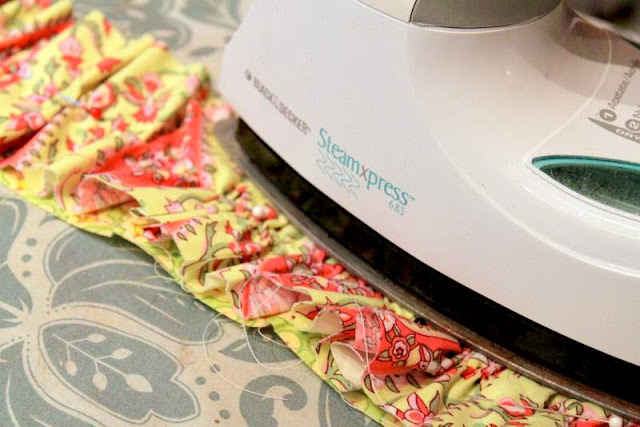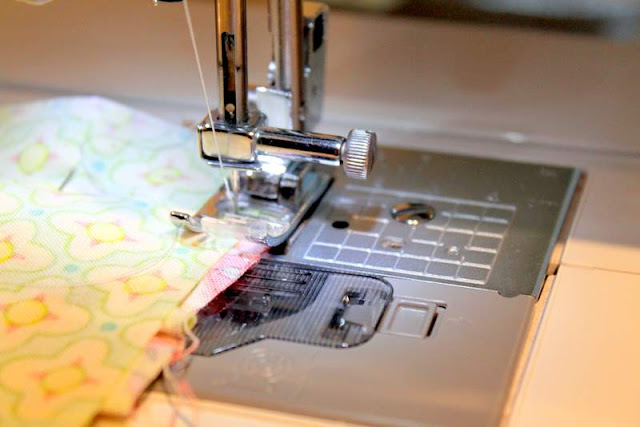First off, I just have to say thank you! Your emails and comments in regards to my camera strap cover "show and tell" post were amazing. I absolutely love hearing from you guys. And because so many of you asked for it, here is a tutorial on how to make your very own, Gathered Camera Strap Cover. Make one for yourself, for a friend, or make multiple to coordinate with every outfit, or how about one for each season or holiday......shoot, the options are endless!
Gathered Camera Strap Cover Tutorial
Supplies:
Two coordinating fabrics (1 for main body and 1 for ruffle)
Fusible fleece
Trim (ribbon, woven trim, ect.)
Sewing machine
Thread
Iron
Ironing board
Directions:
Gather all of your supplies. This camera strap cover will fit a standard DSLR camera strap.
Cut the main strips for your camera strap.
-Cut 2 strips 2.75" x 27" - this will be the main body of the camera strap cover
-Cut 2 strips 3" x 33" - these two strips will be sewn together to make your ruffle
Cut your fusible fleece - you will need one piece 2.75" x 27". Fusible fleece is great for adding extra body or padding to any of your sewing projects. You can usually find fusible fleece in the notions section of your local sewing supply store near the fusible interfacing.
Place your two ruffle strips of fabric, right-sides together and sew.
Sew both strips together along the 3" end (1/4" seam allowance).
Press open your seam. This will make your long ruffle strip which is now approximately 3" x 65.5".
Next apply your fusible fleece to one of the main body pieces of fabric. Apply according to package directions. You will iron the fleece to the wrong-side of the fabric (the side without the pattern).
Press with your iron on both sides. This is what your fabric will look like after you have applied your fleece.
Next, set your sewing machine to the longest stitch length (on my machine it is 5.0). Stitch down the center of your long ruffle strip - DO NOT back-stitch at the beginning OR the end of the strip - I repeat, DO NOT back-stitch. If you back-stitch you will not be able to gather your fabric to make the ruffle. By setting your machine on the longest stitch length this will begin to ruffle the fabric.
This is what your long strip of fabric will look like after you have run your long (gathering) stitch down the center. See how it has begun to look like a ruffle? Well, we need to ruffle it even more!
If you look closely you will notice that there are two threads at the end of your strip. You will need to pull the bobbin thread (which is the thread on the bottom) in order the gather your fabric.
Do you see how my finger is on the bottom of the two threads? This is the bobbin thread. Pull this thread to gather your fabric. There is one at the beginning of the strip and one at the end of the strip. Pull both and slide the fabric along the thread to make the ruffle 27" long.
You need the ruffle to be 27" long to fit perfectly along the top, main body, strip of fabric.
Place your ruffle on top of the main body strip of fabric and pin down the center (this is the piece WITHOUT the fleece). The edges of the ruffle may be a little wider than the main body fabric, but that's ok.
Here is what the ruffle looks like after you have pinned it down the center onto the main body strip of fabric.
Next, press your ruffle on both sides with a hot iron. I highly recommend a steam iron.
This is what the ruffle looks like after it has been pressed.
Now we are going to baste the ruffle in place. Basically we just want to do a little stitching to hold the ruffle in place. So set your stitch length to 3.5 and baste into place (1/8" seam allowance). Sew down both sides of the strip of fabric.
Now that we have secured our ruffle in place it is time for the trim. You can use any trim you like. On my last post, I used a woven, vintage trim, however, this time I decided to use some grosgrain ribbon layered with a thin satin ribbon (it's always fun to change things up). But use whatever coordinates with your fabric.
If you recall from my piping tutorial, I talked about Wonder Tape. Well, here I am using it again - yes, Wonder Tape is WONDER-ful!! Run your tape down the center of your trim and tape into place. If you don't have Wonder-Tape, just pin in place.
Tape your trim straight down the center of the ruffle covering the center stitching.
Stitch your trim into place. Stitch as close to the edge as possible with coordinating thread. Wonder-Tape is amazing at holding trim in place. You can find it in the notions section of your sewing supply store.
I decided to double-layer my trim.
I taped my satin ribbon into place down the center of the grosgrain ribbon and stitched it into place.
Next trim off any ruffle that is wider than the main-body strip of fabric. We cut the ruffle strip fabric a little wider just to make sure it would reach the edge of the main body fabric after being ruffled. But now we want everything to line up for the next step.
Place the ruffle fabric on top of the main body fabric (that has the fusible fleece) - right-sides together.
Stitch down one-side - 1/4" seam allowance.
Here are your two strips sewn together on one side.
Press open the seam. I used my serger to clean up the edge (and because this was for a customer). However, feel free to leave this edge raw.
Fold over both ends 3/4", press and pin in place.
Sew two rows of stitching. First, sew with a 5/8" seam allowance and then move over and sew a 1/4" seam allowance. Do this on both ends. This makes a nice finished look.
At this point, if you plan on using your own labels, stitch them onto the side with the fusible fleece.
Pin the other side (fabric right-sides together) and stitch closed (1/4" seam allowance).
This is what the other side will look like after you have stitched it closed.
Trim off any extra fabric and fleece. Cut fairly close to the seam, but be careful not to cut through the stitching.
Turn your fabric strap cover right-side out. This will take some time and effort, but trust me, it can be done - just keep working it.
After you have turned it right-side out, press to finish and your gathered camera strap cover is complete!
Now slide your DSLR camera strap into the cover. Again, you may have to work it a little to get in in there, but you want it to be snug so it doesn't slide around.
I have had several of you ask me where I purchase my woven clothing labels. I purchase them from Fancy Weaver on Etsy. They do a fabulous job and are very reasonably priced for a text only label. They do take 3-4 weeks to arrive after your order is placed, so just be aware of that before placing your order.
By the way, if you ever have any questions about things related to my business, The Cottage Mama, please don't hesitate to ask - I'm always happy to help!
The fabrics used in this camera strap cover were Amy Butler "Love" (ruffle) and Heather Bailey "Pop Garden" (main body).
If you end up making this super-cute camera strap cover, send me a picture - I would love to see!!
Cottage Mama's Note: Tutorials and patterns on The Cottage Home are for personal use only. If you are interested in using any of the patterns or tutorials seen on this blog for resale, please contact The Cottage Mama at thecottagemama@gmail.com to discuss licensing agreements.




























































0 comments:
Post a Comment